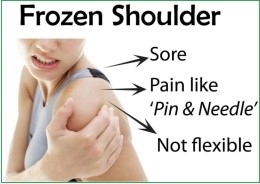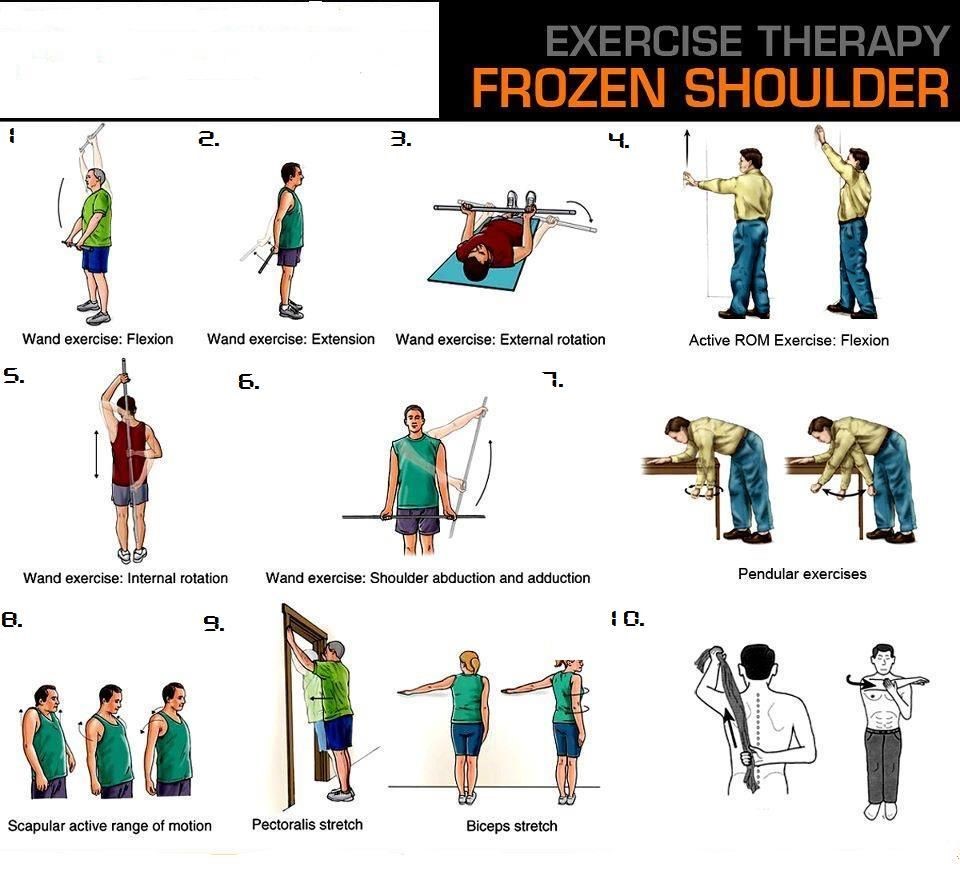Frozen Shoulder
Adhesive capsulitis is the more formal term for frozen shoulder: it describes the characteristic stickiness that develops in the shoulder joint capsule. Sticky shoulder is probably a better name.
In basic terms, it means that your shoulder pain and stiffness is a result of shoulder capsule inflammation (capsulitis) and fibrotic adhesions that limit your shoulder movement.
Causes –
Exact cause is unknown, but there are a number of risk factors predisposing to develop frozen shoulder.
These include:
- Shoulder trauma
- Surgery
- Diabetes
- Inflammatory conditions
- Inactivity of the shoulder
- Hypo/hyperthyroidism
Symptoms –
While frozen shoulder is commonly missed or confused with a rotator cuff injury, it has a distinct pattern of symptoms resulting in severe shoulder pain, loss of shoulder function and eventually stiffness. This condition can last from weeks to months.
Frozen shoulder has three stages, each of which has different symptoms.
The 3 Stages are:
- Freezing
Phase one is characterised by pain around the shoulder initially, followed by a progressive loss of range of movement. This usually lasts anywhere from 3 to 4 months. Aggressive treatment should be avoided in this phase.
2. Frozen
Phase two is where stiffness is dominated. The early transition from phase one to two can be painful. Late phase two is generally pain-free but functionally limiting due to the stiffness.
3. Thawing
Phase three, during this final phase, there is a gradual return of range of movement, but your daily activities might be little limiting. The stage can last 12 to 15 months.
Common issues include:
- Unable to perform above shoulder activities
- Unable to throw a ball
- Unable to quickly reach for something
- Unable to reach behind your back e.g. bra or tuck shirt
- Unable to reach out to your side and behind e.g. reach for seat belt
- Unable to sleep on your side
Treatment –
Treatment for frozen shoulder depends on what stage you are in and is tailored to your specific needs.
Physiotherapy in the initial stage is focused on retaining range of motion in the shoulder joint as well as pain relief. Through a combination of manual therapy, stretches, electrotherapeutic modalities, kinesiology taping and light exercise programs, we can help limit the extent of the condition.
During stage 2, as pain has already decreased, we can work more vigorously on your shoulder to help regain range of motion to speed up your return to a normal lifestyle. Gentle and specific shoulder joint mobilization, muscle release techniques and exercises to regain your range and strength are used for a prompt return to function.
Phase three is the stage that you can start to notice improvement in your daily activities & movements, return to sports with continued vigorous stretches and exercises.
The timeline for recovery from a frozen shoulder can be long and frustrating. It’s important for patients to understand that, the recovery time is measured in months & not just in few weeks.
Do’s and Don’ts –
- DO your mobility exercises on both sides
- DO Attend your sessions – Treatment helps move things along much faster
- DON’T continue doing tasks that cause pain
- DON’T skip sessions or progress your own exercises
“Don’t ignore the stiffness and pain; frozen shoulder can interfere in everyday activities, so visit your Physiotherapist today.”
For further information, reach out to us at –
Pooja Physiotherapy & Health Care Center
Blk 77 Indus road #01-521S’160077
Call now @ 6384 5452 or Whatsapp @ 8322 3371 or
Drop an email at info@physiopooja.com.sg







